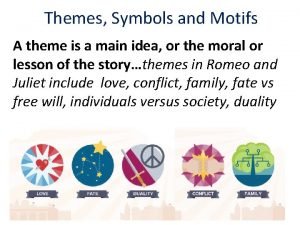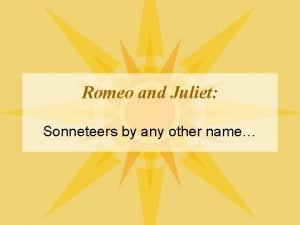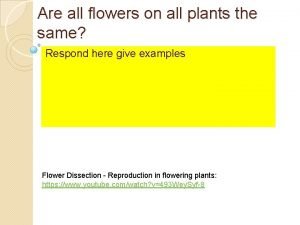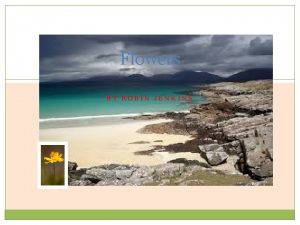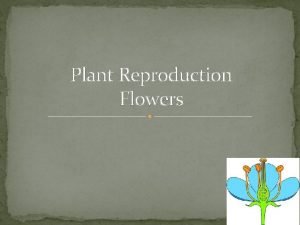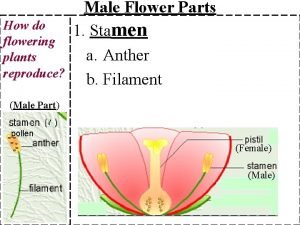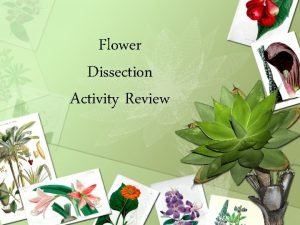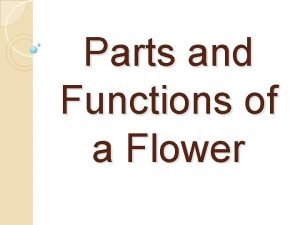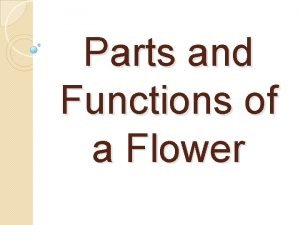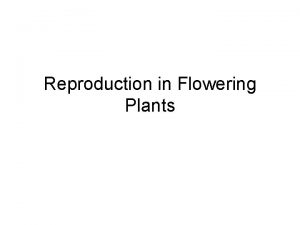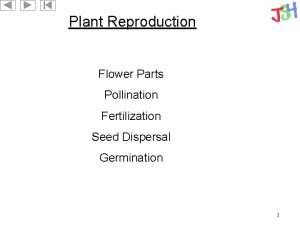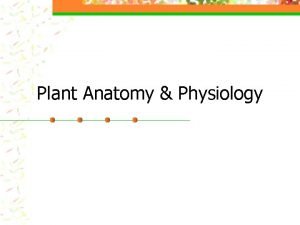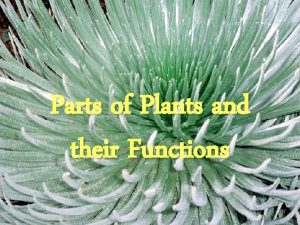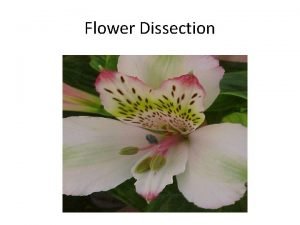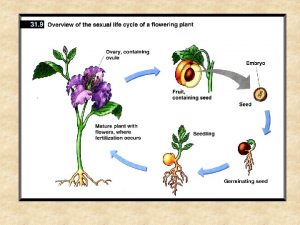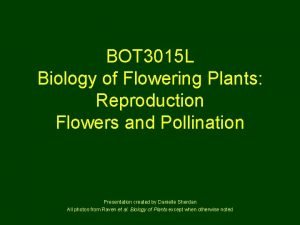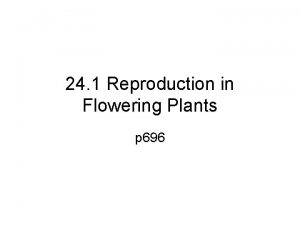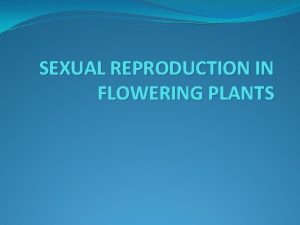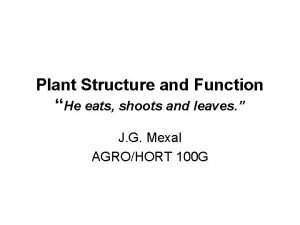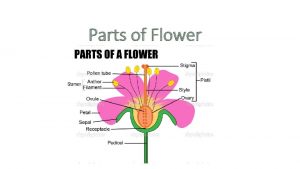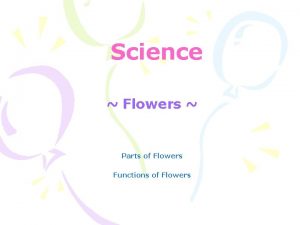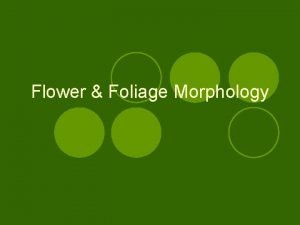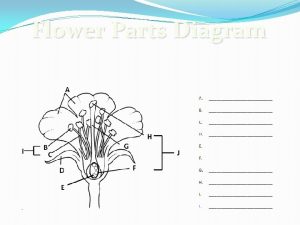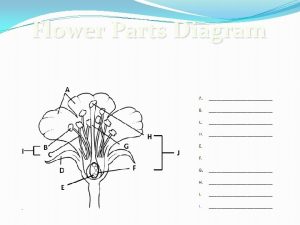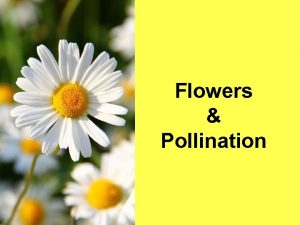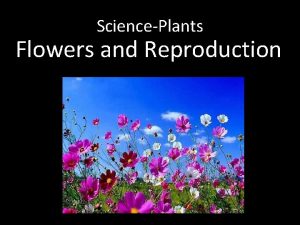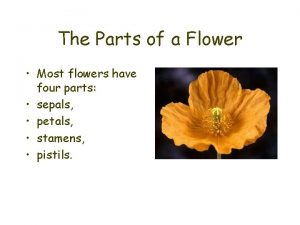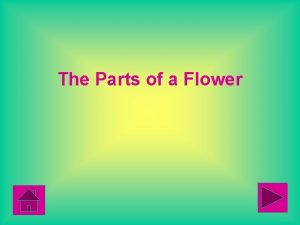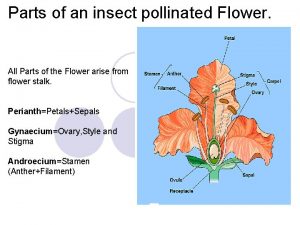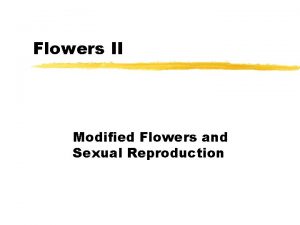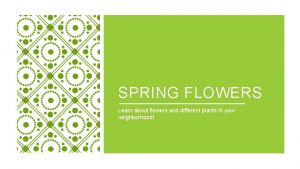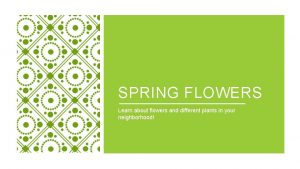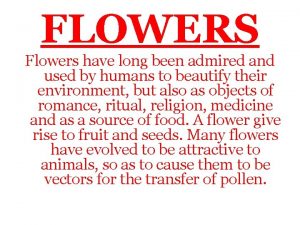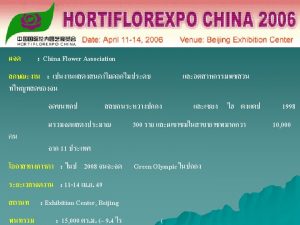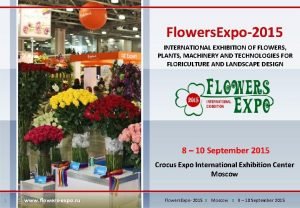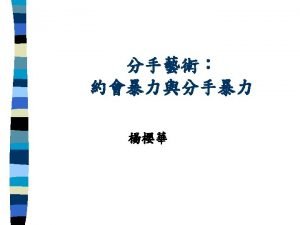Review flowers and flower parts Flower a short




























- Slides: 28

Review: flowers and flower parts Flower = a short, determinate shoot bearing highly modified leaves, some of which are fertile (i. e. , bearing either microsporangia or megasporangia), with the megasporangia in carpels

Flower • REPRODUCTIVE STRUCTURE OF ANGIOSPERMS – Evolutionary requirement to reproduce by sexual means. Pollen transfer and seed dispersal needed. • MODIFIED FOLIAR APPENDAGES – all function together to form the reproductive organ known as the FLOWER. • MODIFICATIONS OF LEAVES – All floral organs are modified LEAVES. Four terminal WHORLS of modified leaves: - Two outermost whorls are sterile (non-meiotic tissues) - Two innermost whorls (sporophylls) are “fertile” with tissues capable of undergoing meiosis • SPOROPHYLLS – those modified leaves with meiotic capacity. - Microsporophylls – stamens – produce pollen in anthers - Megasporophylls – carpels – produce eggs in ovules

Figure 4. 16 from the text

Floral Parts: Major whorls pistil - gynoecium stamens - androecium petals - corolla sepals - calyx receptacle

Figure 4. 21 from the text

Superior, Hypogynous

Superior, Perigynous Floral cup (= hypanthium) present but not fused with the gynoecium

Inferior = Epigynous Hypanthium fused to gynoecium, sometimes extending above it into a conspicuous floral tube.

In a few special cases, the Cactaceae being the main example, epigynous flowers have a hypanthium derived mainly from receptacle tissue.

Rosids – Part 4: Eurosids II - Brassicales - Malvales - Sapindales Spring 2010

Figure 9. 3 from the text “Lower” Core tricolpates “Basal” rosids (Eurosids I) (Eurosids II) Rosids

Core Eudicots: The Rosids Lecture 4 “Basal” Rosids: Order Vitales Eurosids I (Fabids): Order Malpighiales Order Cucurbitales Order Fabales Order Rosales Order Fagales Order Myrtales Eurosids II (Malvids) Order Brassicales Brassicaceae - Mustards Order Malvales Malvaceae – Mallows, cotton, chocolate Order Sapindales Sapindaceae – Maples, lychee Rutaceae – Citrus Anacardiaceae – Mangoes, cashews, poison ivy

Eurosids II: Brassicales: Brassicaceae (‘Cruciferae’ - The Mustard Family) • • Cosmopolitan, most diverse in the Mediterranean region, SW Asia, and western North America Herbs, shrubs or trees; (sometimes herbs); glucosinolates (mustard oils) present in all taxa Diversity: 4, 130 species in 356 genera Flowers: Receptacle prolonged into a gynophore (short to long); Sepals 4; petals 4 (cruciform); stamens 6, all + equal or 2 shorter and 4 longer (tetradynamous); carpels usually 2, connate, superior ovary; fruit is a berry or capsule; if dehiscing by splitting into 2 valves, a silique Significant features: 4 -merous flowers forming a cross; often pioneers after disturbance Special uses: Many important food plants – cabbage, broccoli, cauliflower, brussels sprouts, kohlrabi (Brassica oleracea), turnip (Brassica rapa), mustards (Brassica spp. ), horseradish (Armoracia rusticana), and a wide range of ornamentals Required taxa: Brassica

Brassicaceae cruciform petals tetradynamous stamens silique - silicle

Arabidopsis thaliana The model plant of choice for much of molecular biology.

Brassicaceae: Brassica -annuals or biennials -at least the lower leaves deeply pinnatifid, lyrate or pinnate -racemes without bracts -sepals erect during anthesis -petals yellow -ovary and silique with a prominent beak

Brassica oleracea

Eurosids II: Malvales: Malvaceae (The Mallow Family) • • Cosmopolitan Trees, shrubs, lianas or herbs; vegetative parts with mucilage; leaves palmately veined and lobed or palmately compound Diversity: 2, 330 species in 204 genera Flowers: Sepals & petals 5; stamens 5 to many, monadelphous or polydelphous; carpels 2 to many, connate, superior ovary; fruit usually a loculicidal capsule, also berry, nut, schizocarp, or drupe Significant features: flowers often associated with conspicuous bracts forming an epicalyx; nectaries of densely packed, multicellular glandular hairs, usually on sepals Special uses: cotton (Gossypium), cacao or chocolate (Theobroma), durian (Durio), balsa wood (Ochroma); many ornamentals, e. g. hibiscus (Hibiscus) Required taxa: Hibiscus, Gossypium

Malvaceae Polydelphous stamens Monadelphous stamens

Malvaceae: Hibiscus -herbs or shrubs -epicalyx of a circle of several bractlets -filament column bearing anthers for much of its length -styles distinct -fruit a 5 -locular loculicidal capsule -seeds 2 -several per locule, kidney-shaped

Malvaceae: Gossypium -subshrubs to shrubs -epicalyx of 3 -5 -7 large, cordate, toothed bracts -styles united -fruit a 3 -5 -locular loculicidal capsule -seeds + globular, often with hair (lint)

Eurosids II: Sapindales: Sapindaceae (The Maple Family) • • Mainly tropical and subtropical, a few diverse in the temperate zone (e. g. , Acer, Aesculus) Trees, shrubs or lianas with tendrils Diversity: 2, 215 species in 147 genera Flowers: Usually unisexual; sepals & petals 4 -5, petals often clawed, with more or less basal appendages adaxially; usually an extrastaminal nectar disk present; stamens 8 or fewer (rarely up to 12), filaments usually hairy or papillose; carpels 2 or 3, connate, superior ovary; fruit a capsule, berry, or schizocarp; seeds with a deep fold or pocket in the seed coat Significant features: cyclopropane amino acids Special uses: lumber, maple syrup (Acer saccharum); many ornamentals; tropical fruits (longan, lychee, rambutan) Required taxa: Acer

Sapindaceae phylogeny SAP HIPP SAP SAP Chemistry Appendaged petals Curved embryo w/ seed coat “pocket” 8 or fewer stamens Etc. SAP ACER

Sapindaceae: Acer -trees or sometimes shrubs -leaves opposite, simple and palmately lobed, rarely pinnately or palmately compound -calyx usually 5 -lobed -petals 0 or as many as the calyx lobes -ovary with 2 connate, winged carpels, 2 ovules per carpel -fruit a schizocarp, splitting into 2 samaroid mericarps

Eurosids II: Sapindales: Rutaceae (The Citrus Family) • • Nearly cosmopolitan, primarily tropical to subtropical Trees or shrubs, sometimes with thorns, spines or prickles Diversity: 930 species in 155 genera Flowers: Sepals & petals 4 – 5; stamens 8 -10; carpels 4 -5 to many, connate, superior ovary; axile placentation; fruit a drupe, capsule, samara, cluster of follicles or modified berry with leathery, glandular rind (i. e. , hesperidium in Citrus). Significant features: Aromatic oils chemically complex; simple or compound leaves with pellucid dots containing aromatic ethereal oils Special uses: many desirable fruits - oranges, lemons, limes, tangerine, grapefruit (Citrus), kumquat (Fortunella), several ornamentals, e. g. cork tree (Phellodendron) Required taxa: Citrus

Rutaceae: Citrus -leaves apparently simple, of 1 leaflet -ovary compound, entire or only slightly lobed -fruit a hesperidium

Eurosids II: Sapindales: Anacardiaceae (The Sumac or Cashew Family) • • Mainly pantropical; some in temperate regions Trees, shrubs, or lianas; well-developed resin canals; leaves usually pinnately compound & alternate Diversity: 600 species in 70 genera Flowers: Usually unisexual; Sepals & petals 5; stamens 510; carpels usually 3, connate, but usually only 1 carpel fully developed and fertile; superior ovary; fruit is a drupe, frequently flattened and asymmetrical Significant features: Medically-important – poison-ivy (Toxicodendron radicans) and other taxa (Rhus, Metopium) cause contact dermatitis due to oils in plant tissues. Some individuals are even allergic to ‘edible’ taxa. Special uses: mangoes (Mangifera indica), cashews (Anacardium occidentale), pistachio (Pistacia vera); some ornamentals, e. g. Sumac (Rhus) and smoke-tree (Cotinus) Required taxa: Toxicodendron

Anacardiaceae: Toxicodendron T. radicans - Poison Ivy -resins toxic -inflorescences axillary panicles -fruits glabrous, greenish to white
 Tall+short h
Tall+short h Jenna has 16 red flowers and 24 yellow flowers
Jenna has 16 red flowers and 24 yellow flowers Romeo and juliet symbols
Romeo and juliet symbols Sweet flower with flowers thy bridal
Sweet flower with flowers thy bridal Do all flowers have male and female parts
Do all flowers have male and female parts The flowers alice walker theme
The flowers alice walker theme Flowers of algernon short story
Flowers of algernon short story The flowers alice walker
The flowers alice walker Flowers by robin jenkins
Flowers by robin jenkins What part of the flower makes pollen
What part of the flower makes pollen Parts of a flower and their functions
Parts of a flower and their functions Female and male parts of a flower
Female and male parts of a flower Female parts of plants
Female parts of plants The male parts of a flower
The male parts of a flower Stigma fuction
Stigma fuction Function of flower part
Function of flower part Tulip wind turbines
Tulip wind turbines Regular vs irregular flowers
Regular vs irregular flowers Plants have male and female parts
Plants have male and female parts Ovary
Ovary Parts of a plant foldable
Parts of a plant foldable Parts of a flower objectives
Parts of a flower objectives What are the functions of a seed
What are the functions of a seed Alstroemeria anatomy
Alstroemeria anatomy Calyx parts
Calyx parts Inferior ovary
Inferior ovary What part of the flower is female
What part of the flower is female Agamospory
Agamospory Function of plumule and radicle
Function of plumule and radicle


